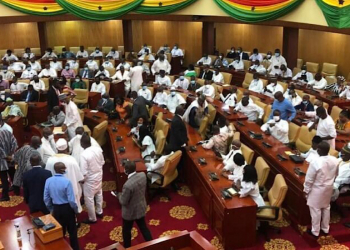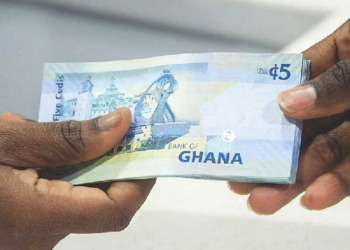A flock of birds chirp endlessly. Tall trees nearby whisper breezes and chainsaw roars a stone throw away. Shrubs and climbers envelope stumps and wild grasses bloom. The sun is hot, the breeze is cold but the ground is wet with giant footprints of tractors.
This is the Kweikaru Forest Reserve where giant trees have fallen to merchants of the timber industry, leaving it degraded, but its restoration is on the shoulders of Newmont Golden Ridge Limited (Akyem Mine), a mining company, operating in the Ajenua Bepo Forest Reserve in the Eastern Region.
Offsetting impact
Although the company’s operation is nowhere close to Kweikaru Forest Reserve, the Akyem mine operates open pit mining on 101 hectares of degraded portions of the Ajenua Bepo Forest Reserve. The reforestation programme, therefore, forms part of the mine’s mitigation measures rolled out in consultation with the Forestry Commission to offset the impact of its operations on the forest reserve.
Over 257 hectares of degraded land in the Kweikaru Forest Reserve has been handed over to the Akyem mine for the reforestation programme. This was the outcome of a memorandum of understanding (MoU) signed between the Forestry Commission (FC) and the mining company last year. As part of the MoU, the Commission provides technical support in terms of supervision and monitoring.
The project is the second phase of Newmont’s reforestation programme, which will see the company nurse seeds and nurture seedlings, plant seedlings and manage these for the next 10 years. The first phase begun in 2014 and it covered 60 hectares of the boundary area between the company’s mining area and the Mamang River Forest Reserve.
The two projects will together cover more than 317 hectares, which is a little more than three times Newmont’s current mining area in the Ajenua Bepo Forest Reserve, and involves replanting indigenous species, including Wawa, Mahogany, Emre, Mansonia, Sapele, Odum, Kyenkyen, Ofram, Kusia, Bako and Asanfena and one exotic species— Cedrela.
Newmont also operates a giant nursery where hundreds of seedlings are kept for the purposes of replacing seedlings that do not survive on the field.
Phase Two
The Reforestation Project at the Kweikaru Forest Reserve has been divided into five blocks, with each block having a different planting design because of the diverse vegetation. There are parts of the forest that have not been degraded much so need enrichment planting. Site preparation for the phase two started on September 27, 2016.
“The other four blocks will be cleared manually and every timber tree with promising bole will not be tampered with but nurtured together with the seedling that would be planted,” Mr Emmanuel Baffour-Asare, Environmental Superintendent, Akyem Mine, told the Daily Graphic. Out of the 300,000 seedlings meant for the reforestation project in Kweikaru Forest Reserve, 100,000 are indigenous and 200,000 Cedrela species. The end product of Cedrela is veneer, which is used massively in the furniture industry globally.
The selection of the timber species are based on studies conducted by the Forest Services Division of the Forestry Commission on past and existing trees that thrived on the land, before being given out on concession to timber contractors.
“The place looks green so people think it’s a forest. But it is full of climbers and Acheampong weed (Chromolaena odorata),” he said in reference to part of the forest reserve, which looked more like a fallow farmland than a forest reserve.
A few kilometres away from the Newmont Akyem mine through a well beaten path is a giant plantation—the first phase of the company’s reforestation project.
Here, the whole 60 hectares has been planted with 30 indigenous species and one exotic species (Cedrela) with the District Manager, Forest Services Division, Kade, Mr Samuel Opoku, describing the project as being successful because more than 75 per cent of the trees planted survived.
Under the flourishing canopy of trees were a group of young men clearing weeds and pruning branches of the fast-growing trees that is being maintained since establishment in June, 2014. They are employees of Wellbamax Enterprise, one of three local-local companies operating in the immediate environs of the mine that won a competitive bidding process to establish and maintain the plantation.
Mr Kwame Tawiah, the Chief Executive Officer of Wellbamax Enterprise, told the Daily Graphic that beyond the project creating job for young people in nearby communities, the plantation would serve the communities in other ways. In all, more than 66 people were engaged during the initial stages but it would be trimmed down to half when the project enters the maintenance phase for the next 10 years.
“The communities are grateful because of the diversity in the trees planted because when one tree is fell in the future, we will have a lot for roofing, furniture as well as income for our communities. We have worked for almost three years. We are very happy for the opportunity,” Mr Tawiah said.
The FSD local boss, Mr Opoku, agreed with the observation, saying, “Every tree that is taken out from the forest, the community benefits. We have so many stakeholders who benefit, the District Assembly, the stool land owners and traditional authorities also benefit. If at the end of the day hundred trees are removed from the plantation site, you can imagine the financial benefits.”
“Other benefits the communities will also enjoy is that with the existence of the forest, they are taking what we call non-timber forest products (NTFPs). Once we are able to replenish the area, those non-timber forest produce are going to flow, for them to get the benefit. They hunt from the forest, when it is degraded, the animals are not in, but when replenished, their habitats have been restored.”
Mr Baffour-Asare also had an interesting view on the plantation saying it was strategic because it borders the Mamang River Forest Reserve, adding that “this area was strategically used to serve as a buffer to prevent people from entering the main forest reserve.”
With its operations surrounded by forest reserves, Mr Baffour-Asare said the company had a very strict policy on protecting biodiversity.
“Per Newmont’s standard and commitment on biodiversity, we highly protect biodiversity; be it plant or fauna so we don’t kill animals on site and we do not burn weeds too onsite. During the land preparation, fire was never used so that animals that are around including those in the soil are not affected. It is one way of protecting the fauna.”
“When you see an animal you don’t kill it. If you think the animal poses danger, you move out of that area, and call some of us who have been trained to capture and translocate the animals.”
“When the land was being cleared, they encountered a lot of vipers, I came to capture and send them to the forest reserve so that when in some few years this habitat is restored, they will move back and colonise the area. It is only two years but you can hear birds whispering,” he added.
Newmont has shown with it reforestation project that mining can be done responsibly and sustainably but the role of regulators are also as important.
Join GhanaStar.com to receive daily email alerts of breaking news in Ghana. GhanaStar.com is your source for all Ghana News. Get the latest Ghana news, breaking news, sports, politics, entertainment and more about Ghana, Africa and beyond.
(Via: CitiFM Online Ghana)




